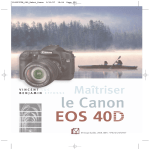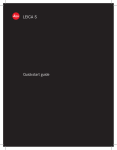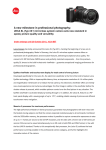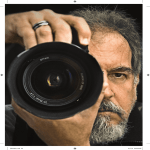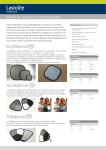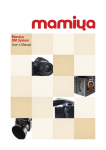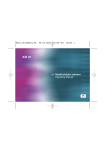Download Lastolite ePhotomaker
Transcript
Setting up your ePhotomaker 1 3 5 7 9 2 4 6 Please read these instructions thoroughly before you assemble and use the ePhotomaker. 1. Remove the contents from the blue carry case. Please note that the grey card may flip open as you take it out. 2. Check the contents, they should include: 1x ePhotomaker, 1x Support rod (folded in a loop), 1x Ezybalance grey card, 1x Mini tripod, 1x Carry case, 1x Blue 'daylight' film, 2x Double ended clips. 3. Take hold of the ePhotomaker by one of the black rims and give it a shake. It will automatically pop-out to form a tent shape with triangular side panels. 4. Position the two rounded triangular side panels to form a tent shape with the open side facing you. 5. Tip the ePhotomaker up 90 degrees so that it rests on the back panel. 6. Take hold of the support rod and locate the yellow Velcro tabs. Separate the tabs and slowly let the rod straighten out, whilst keeping hold of the velcro tabs at each end. 7. Attach the support rod by fixing the yellow Velcro tabs on the rod to the yellow Velcro tabs attached to the black rim of the ePhotomaker, then turn the ePhotomaker back 90 degrees onto its base. 8. Position the mini tripod in front of the ePhotomaker and turn the locking screw anti-clockwise to allow the ball and socket joint to rotate freely. 9. Attach your camera by screwing the top plate of the tripod clockwise into the tripod mount on the base of your camera. Then tighten the locking screw so the ball and socket joint can no longer move. 8 10 12 1 2 3 4 What does the blue ‘daylight’ film do? Most desk lamps incorporate a tungsten/ incandescent bulb which gives a slightly yellow coloured light. Using the blue film will help compensate for the yellow colour and simulate ‘daylight’ conditions with less colour cast. 12. Finally turn the flash on your camera to the OFF position (refer to your camera manual for instructions on how to do this). You are now ready to arrange your first shot. 1. The sewn in fabric can be used as your background or alternatively for a smoother finish you could insert a paper/card sheet. This option is particularly useful if you want your images on a coloured background. 2. Position the object you want to photograph centrally inside the ePhotomaker. 3. Adjust the angle of the lamp to position the lighting to suit the object being photographed. 4. Compose/frame the object in the viewfinder or LCD screen of your camera as you would like to see the finished image. Your now ready to press the shutter button and take the photograph. Depending on which type of camera you are using there are some additional settings that you may need to consider before you actually press the shutter. Please see below Taking the photograph 1 2 Using a Traditional Film Camera Check that the film you are using has been balanced to work with the light source you have chosen. The optional blue film can be used to adjust your tungsten/incandescent light source to simulate ‘daylight’ if required. Using a Digital Camera (with optional manual mode) Select the manual mode and ‘white balance’ your camera to your chosen light source following the instructions in your camera manual (use the blue ‘daylight’ film if required). See examples below. 3 10. To position your camera to take a photograph, you can adjust the tilt and rotation of the camera by using the locking screw. The height can also be adjusted by extending the telescopic legs of the tripod. 11. Position your desk lamp on the left hand side of the ePhotomaker. Then attach the blue 'daylight' film (if required) onto the front of your lamp using the clips provided. The clips will need assembling first (see separate instructions with the clips). 11 Arranging the object Another useful feature to consider altering is EV compensation. This adjusts the lightness/darkness of your image. Again, consult your manual for further instructions. See examples below. Using a Digital Camera (with automatic mode only) The effects of using EV compensation. EV +0 EV +2/3 EV +12/3 If you only have an ‘automatic’ mode you may find it useful to use the greycard and the blue ‘daylight’ film as follows: 1. Place the grey card inside the ePhotomaker in front of the object you want to photograph. Make sure the printed 'crosshair' is in the centre of the image and as close to the subject as possible. 2. With the grey card in position, half depress the shutter on your camera. This locks the focus on the 'crosshair' and automatically takes exposure readings from the card. 3. Finally, while still holding the shutter in the half depress position, remove the grey card from the ePhotomaker and then press the shutter all the way down. Your photograph is now taken. The effects of altering the white balance Incorrect Correct Packing away your ePhotomaker 1 3 5 7 2 1. Remove the camera from the tripod by first loosening the locking screw on the tripod and then turning the top plate anti-clockwise. 2. Tip the ePhotomaker up 90 degrees so that it rests on the back panel and remove the support rod. Bend the rod to form a loop and attach the two yellow Velcro tabs to each other. 3. Close the two triangular side panels of the ePhotomaker together so that they lie flat against each other and take hold of the left and right corners of the bottom edge of the ePhotomaker. 4. Slowly start to bring your hands together while still holding the ePhotomaker. This will cause the ePhotomaker to bend into a crisp shape. 5. As your hands are about to touch, continue pushing but let your right hand slowly pass underneath the left. 6. The pointed end of the triangular panels will automatically fold underneath. 7. Use the same technique to fold the grey card. 8. Unclip the blue 'daylight' film from the lamp then place all the items back into the blue carry case. 4 6 8 Instructions www.ephotomaker.co.uk


